Comprehensive Analysis: Safety & Health Management in Oil and Gas
VerifiedAdded on 2023/06/10
|24
|6049
|371
Report
AI Summary
This report provides an overview of safety and health management within the oil and gas industry, focusing on medical emergency response (MER) in offshore locations. It examines the legal requirements, industry standards, and challenges associated with providing medical care to offshore workers, including the epidemiology of injuries and illnesses. The report also discusses the importance of training and qualifications for medical personnel working in remote environments, highlighting the need for advanced skills in cardiac and trauma life support. Furthermore, it addresses the limitations of traditional remote site emergency management and the evolving role of technology in improving medical care delivery in the oil and gas sector. The document concludes by emphasizing the importance of adhering to guidelines set forth by organizations like OGUK and OGP to ensure adequate medical facilities and equipment are available for offshore installations.
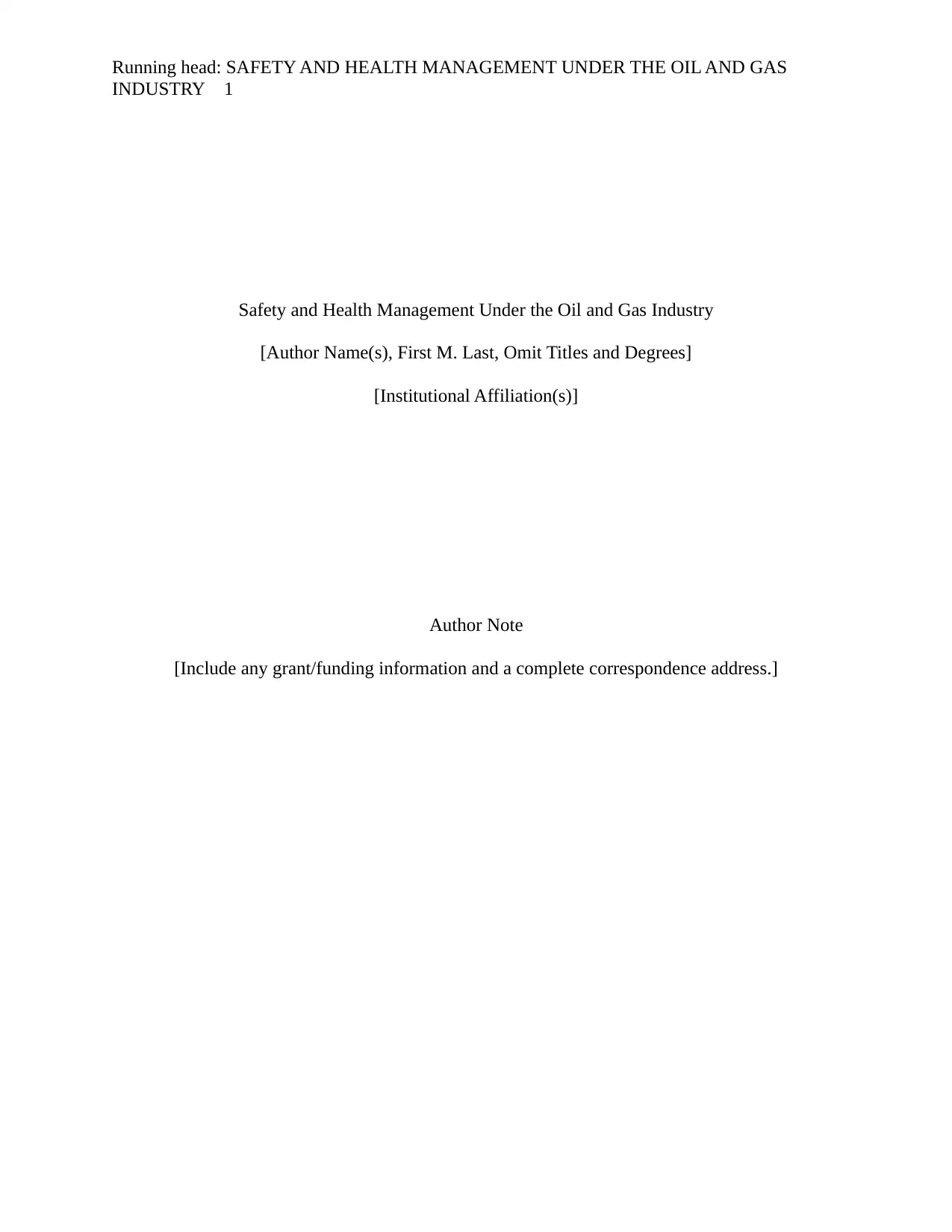
Running head: SAFETY AND HEALTH MANAGEMENT UNDER THE OIL AND GAS
INDUSTRY 1
Safety and Health Management Under the Oil and Gas Industry
[Author Name(s), First M. Last, Omit Titles and Degrees]
[Institutional Affiliation(s)]
Author Note
[Include any grant/funding information and a complete correspondence address.]
INDUSTRY 1
Safety and Health Management Under the Oil and Gas Industry
[Author Name(s), First M. Last, Omit Titles and Degrees]
[Institutional Affiliation(s)]
Author Note
[Include any grant/funding information and a complete correspondence address.]
Paraphrase This Document
Need a fresh take? Get an instant paraphrase of this document with our AI Paraphraser
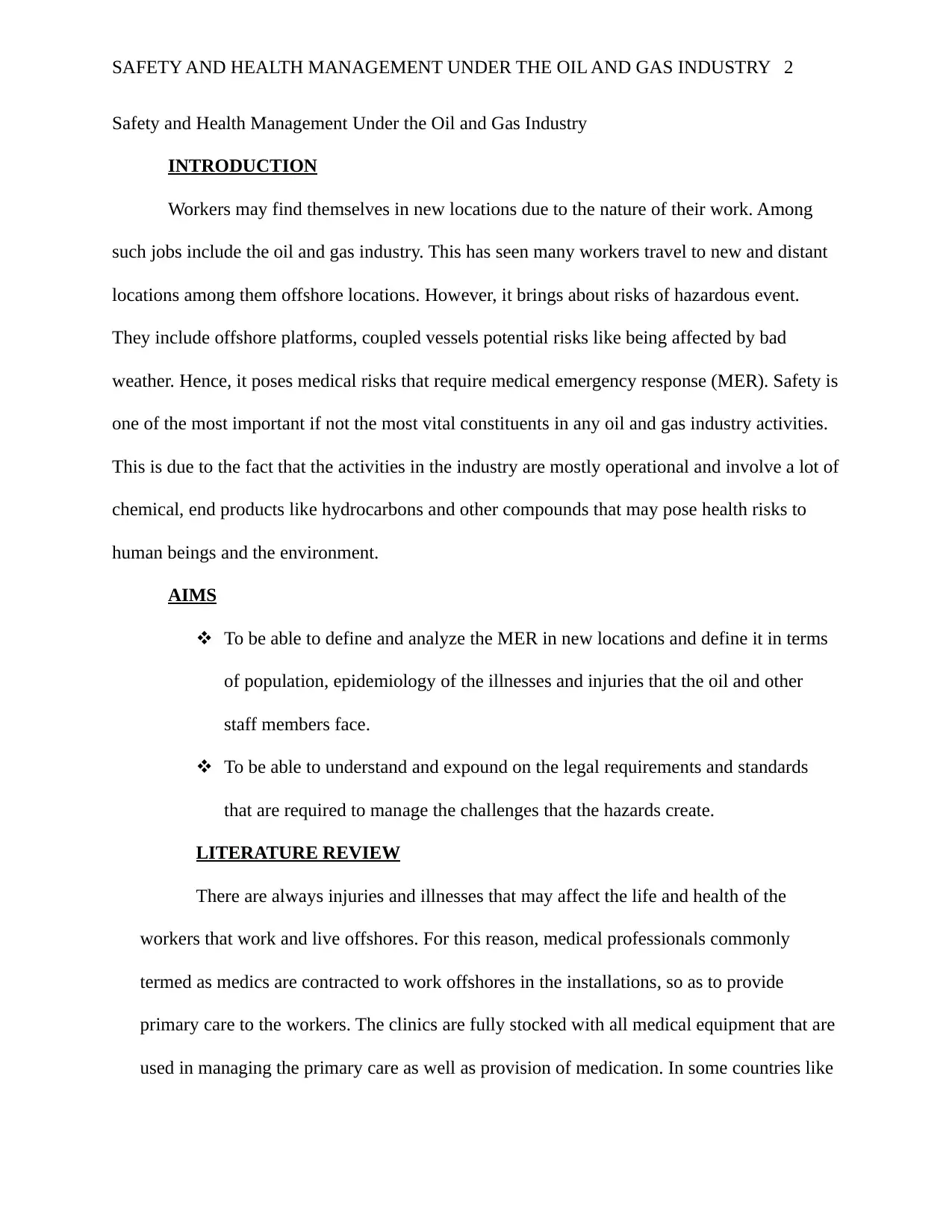
SAFETY AND HEALTH MANAGEMENT UNDER THE OIL AND GAS INDUSTRY 2
Safety and Health Management Under the Oil and Gas Industry
INTRODUCTION
Workers may find themselves in new locations due to the nature of their work. Among
such jobs include the oil and gas industry. This has seen many workers travel to new and distant
locations among them offshore locations. However, it brings about risks of hazardous event.
They include offshore platforms, coupled vessels potential risks like being affected by bad
weather. Hence, it poses medical risks that require medical emergency response (MER). Safety is
one of the most important if not the most vital constituents in any oil and gas industry activities.
This is due to the fact that the activities in the industry are mostly operational and involve a lot of
chemical, end products like hydrocarbons and other compounds that may pose health risks to
human beings and the environment.
AIMS
To be able to define and analyze the MER in new locations and define it in terms
of population, epidemiology of the illnesses and injuries that the oil and other
staff members face.
To be able to understand and expound on the legal requirements and standards
that are required to manage the challenges that the hazards create.
LITERATURE REVIEW
There are always injuries and illnesses that may affect the life and health of the
workers that work and live offshores. For this reason, medical professionals commonly
termed as medics are contracted to work offshores in the installations, so as to provide
primary care to the workers. The clinics are fully stocked with all medical equipment that are
used in managing the primary care as well as provision of medication. In some countries like
Safety and Health Management Under the Oil and Gas Industry
INTRODUCTION
Workers may find themselves in new locations due to the nature of their work. Among
such jobs include the oil and gas industry. This has seen many workers travel to new and distant
locations among them offshore locations. However, it brings about risks of hazardous event.
They include offshore platforms, coupled vessels potential risks like being affected by bad
weather. Hence, it poses medical risks that require medical emergency response (MER). Safety is
one of the most important if not the most vital constituents in any oil and gas industry activities.
This is due to the fact that the activities in the industry are mostly operational and involve a lot of
chemical, end products like hydrocarbons and other compounds that may pose health risks to
human beings and the environment.
AIMS
To be able to define and analyze the MER in new locations and define it in terms
of population, epidemiology of the illnesses and injuries that the oil and other
staff members face.
To be able to understand and expound on the legal requirements and standards
that are required to manage the challenges that the hazards create.
LITERATURE REVIEW
There are always injuries and illnesses that may affect the life and health of the
workers that work and live offshores. For this reason, medical professionals commonly
termed as medics are contracted to work offshores in the installations, so as to provide
primary care to the workers. The clinics are fully stocked with all medical equipment that are
used in managing the primary care as well as provision of medication. In some countries like
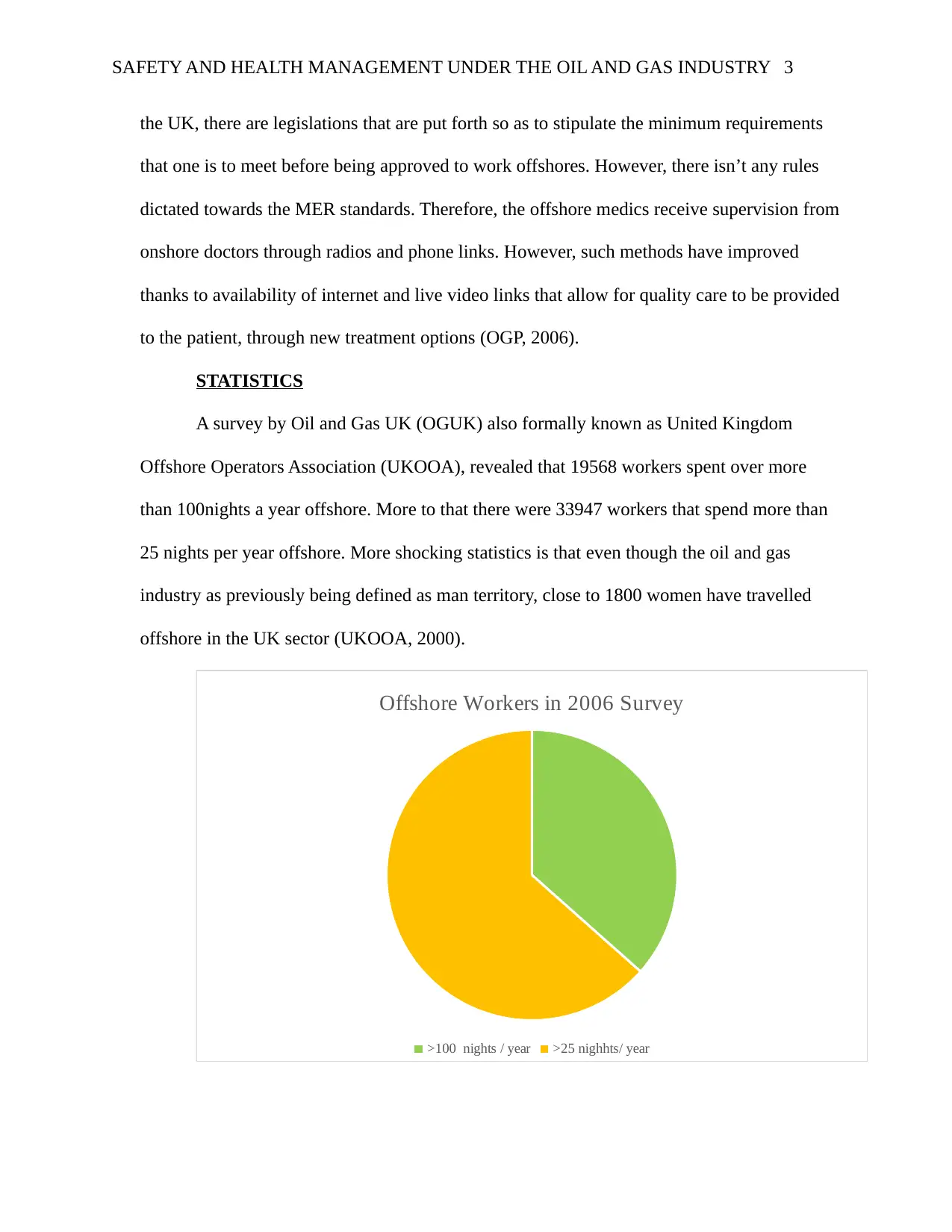
SAFETY AND HEALTH MANAGEMENT UNDER THE OIL AND GAS INDUSTRY 3
the UK, there are legislations that are put forth so as to stipulate the minimum requirements
that one is to meet before being approved to work offshores. However, there isn’t any rules
dictated towards the MER standards. Therefore, the offshore medics receive supervision from
onshore doctors through radios and phone links. However, such methods have improved
thanks to availability of internet and live video links that allow for quality care to be provided
to the patient, through new treatment options (OGP, 2006).
STATISTICS
A survey by Oil and Gas UK (OGUK) also formally known as United Kingdom
Offshore Operators Association (UKOOA), revealed that 19568 workers spent over more
than 100nights a year offshore. More to that there were 33947 workers that spend more than
25 nights per year offshore. More shocking statistics is that even though the oil and gas
industry as previously being defined as man territory, close to 1800 women have travelled
offshore in the UK sector (UKOOA, 2000).
Offshore Workers in 2006 Survey
>100 nights / year >25 nighhts/ year
the UK, there are legislations that are put forth so as to stipulate the minimum requirements
that one is to meet before being approved to work offshores. However, there isn’t any rules
dictated towards the MER standards. Therefore, the offshore medics receive supervision from
onshore doctors through radios and phone links. However, such methods have improved
thanks to availability of internet and live video links that allow for quality care to be provided
to the patient, through new treatment options (OGP, 2006).
STATISTICS
A survey by Oil and Gas UK (OGUK) also formally known as United Kingdom
Offshore Operators Association (UKOOA), revealed that 19568 workers spent over more
than 100nights a year offshore. More to that there were 33947 workers that spend more than
25 nights per year offshore. More shocking statistics is that even though the oil and gas
industry as previously being defined as man territory, close to 1800 women have travelled
offshore in the UK sector (UKOOA, 2000).
Offshore Workers in 2006 Survey
>100 nights / year >25 nighhts/ year
⊘ This is a preview!⊘
Do you want full access?
Subscribe today to unlock all pages.

Trusted by 1+ million students worldwide
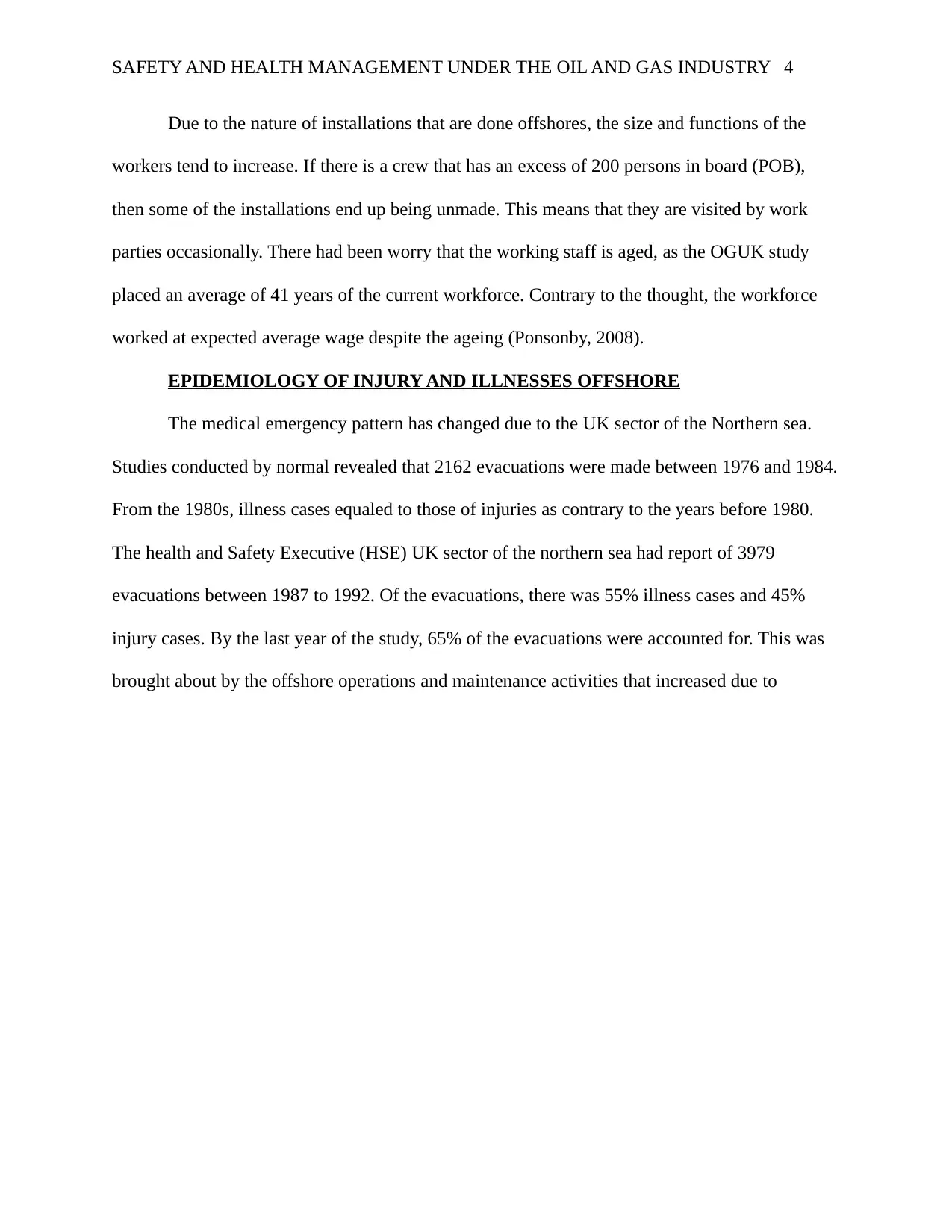
SAFETY AND HEALTH MANAGEMENT UNDER THE OIL AND GAS INDUSTRY 4
Due to the nature of installations that are done offshores, the size and functions of the
workers tend to increase. If there is a crew that has an excess of 200 persons in board (POB),
then some of the installations end up being unmade. This means that they are visited by work
parties occasionally. There had been worry that the working staff is aged, as the OGUK study
placed an average of 41 years of the current workforce. Contrary to the thought, the workforce
worked at expected average wage despite the ageing (Ponsonby, 2008).
EPIDEMIOLOGY OF INJURY AND ILLNESSES OFFSHORE
The medical emergency pattern has changed due to the UK sector of the Northern sea.
Studies conducted by normal revealed that 2162 evacuations were made between 1976 and 1984.
From the 1980s, illness cases equaled to those of injuries as contrary to the years before 1980.
The health and Safety Executive (HSE) UK sector of the northern sea had report of 3979
evacuations between 1987 to 1992. Of the evacuations, there was 55% illness cases and 45%
injury cases. By the last year of the study, 65% of the evacuations were accounted for. This was
brought about by the offshore operations and maintenance activities that increased due to
Due to the nature of installations that are done offshores, the size and functions of the
workers tend to increase. If there is a crew that has an excess of 200 persons in board (POB),
then some of the installations end up being unmade. This means that they are visited by work
parties occasionally. There had been worry that the working staff is aged, as the OGUK study
placed an average of 41 years of the current workforce. Contrary to the thought, the workforce
worked at expected average wage despite the ageing (Ponsonby, 2008).
EPIDEMIOLOGY OF INJURY AND ILLNESSES OFFSHORE
The medical emergency pattern has changed due to the UK sector of the Northern sea.
Studies conducted by normal revealed that 2162 evacuations were made between 1976 and 1984.
From the 1980s, illness cases equaled to those of injuries as contrary to the years before 1980.
The health and Safety Executive (HSE) UK sector of the northern sea had report of 3979
evacuations between 1987 to 1992. Of the evacuations, there was 55% illness cases and 45%
injury cases. By the last year of the study, 65% of the evacuations were accounted for. This was
brought about by the offshore operations and maintenance activities that increased due to
Paraphrase This Document
Need a fresh take? Get an instant paraphrase of this document with our AI Paraphraser
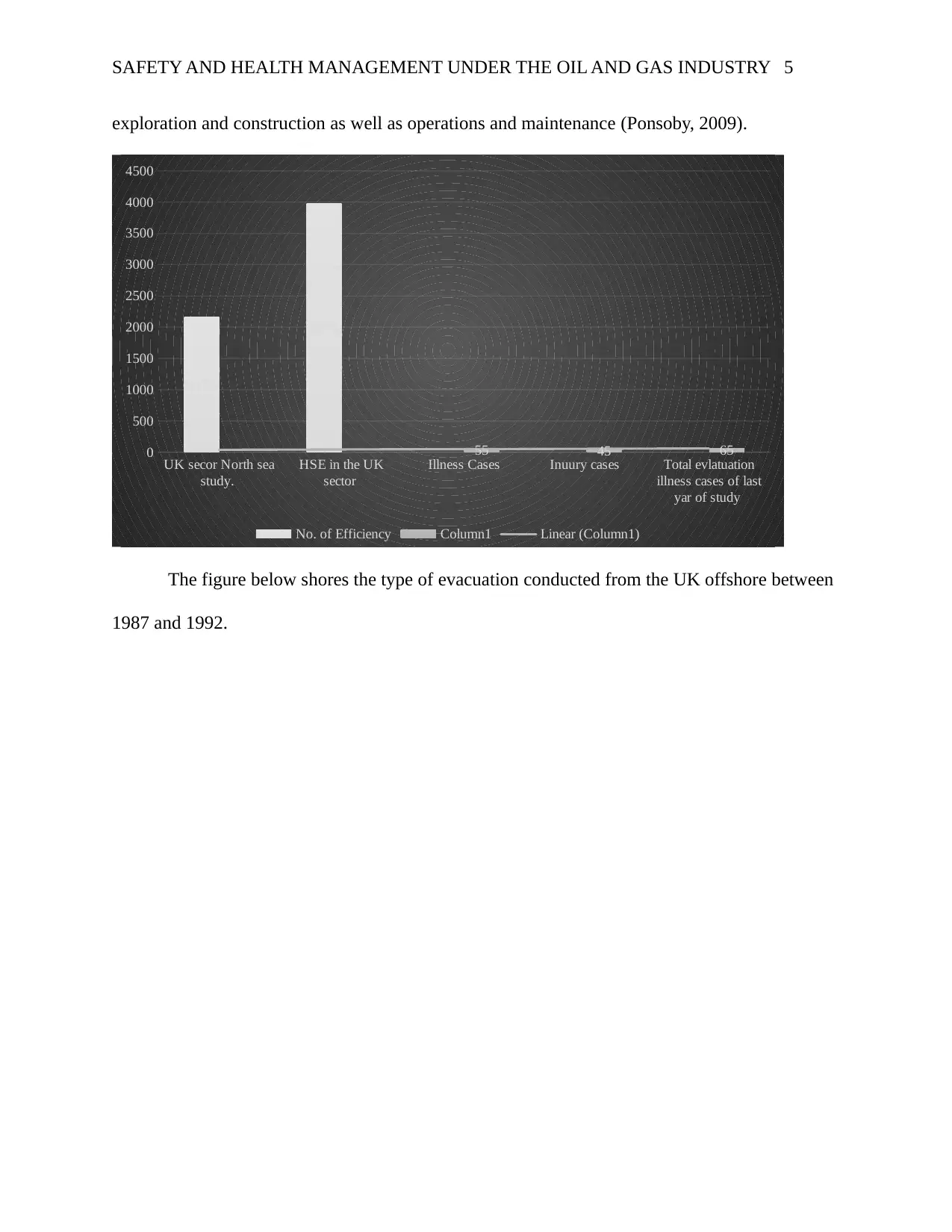
SAFETY AND HEALTH MANAGEMENT UNDER THE OIL AND GAS INDUSTRY 5
exploration and construction as well as operations and maintenance (Ponsoby, 2009).
UK secor North sea
study.
HSE in the UK
sector
Illness Cases Inuury cases Total evlatuation
illness cases of last
yar of study
0
500
1000
1500
2000
2500
3000
3500
4000
4500
2162
3979
55 45 65
No. of Efficiency Column1 Linear (Column1)
The figure below shores the type of evacuation conducted from the UK offshore between
1987 and 1992.
exploration and construction as well as operations and maintenance (Ponsoby, 2009).
UK secor North sea
study.
HSE in the UK
sector
Illness Cases Inuury cases Total evlatuation
illness cases of last
yar of study
0
500
1000
1500
2000
2500
3000
3500
4000
4500
2162
3979
55 45 65
No. of Efficiency Column1 Linear (Column1)
The figure below shores the type of evacuation conducted from the UK offshore between
1987 and 1992.
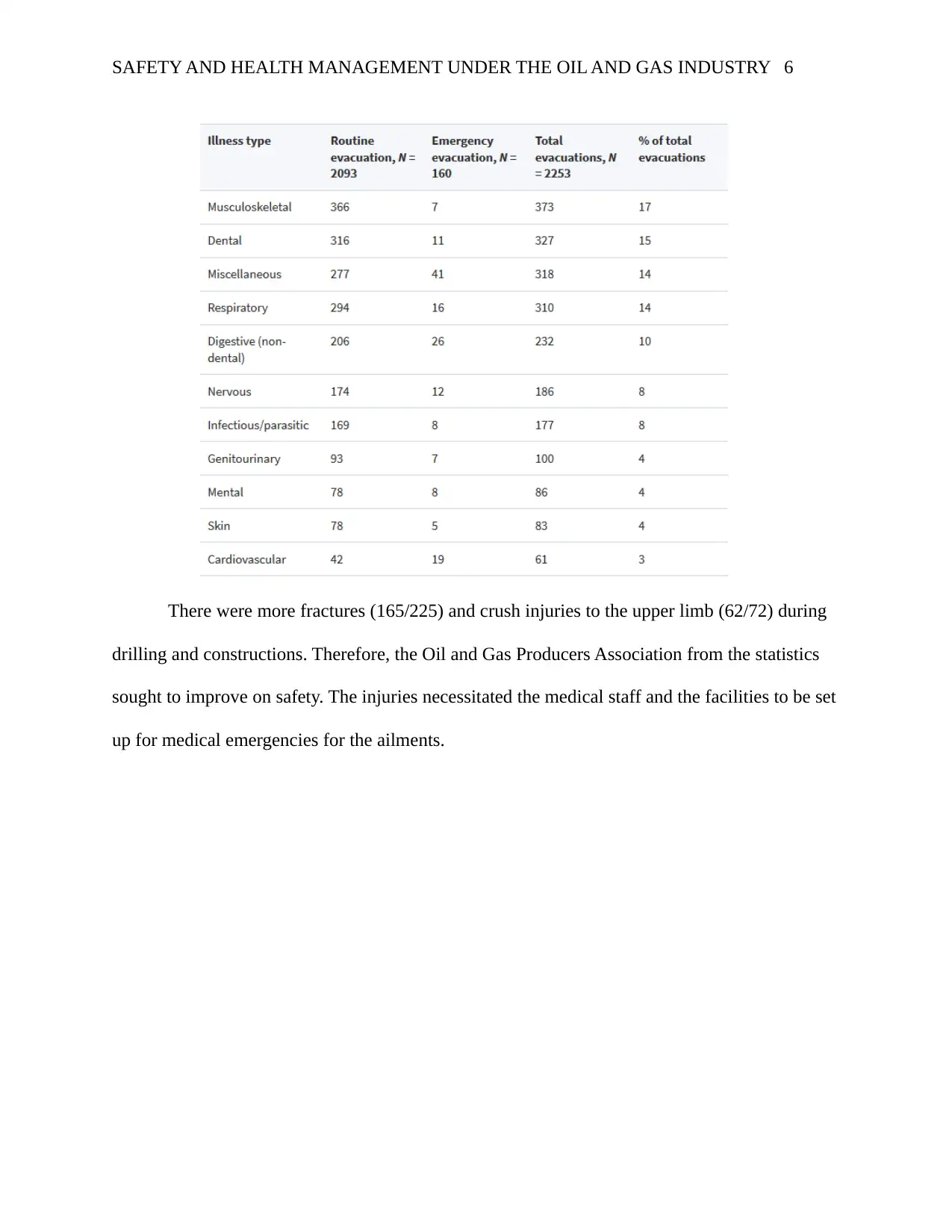
SAFETY AND HEALTH MANAGEMENT UNDER THE OIL AND GAS INDUSTRY 6
There were more fractures (165/225) and crush injuries to the upper limb (62/72) during
drilling and constructions. Therefore, the Oil and Gas Producers Association from the statistics
sought to improve on safety. The injuries necessitated the medical staff and the facilities to be set
up for medical emergencies for the ailments.
There were more fractures (165/225) and crush injuries to the upper limb (62/72) during
drilling and constructions. Therefore, the Oil and Gas Producers Association from the statistics
sought to improve on safety. The injuries necessitated the medical staff and the facilities to be set
up for medical emergencies for the ailments.
⊘ This is a preview!⊘
Do you want full access?
Subscribe today to unlock all pages.

Trusted by 1+ million students worldwide
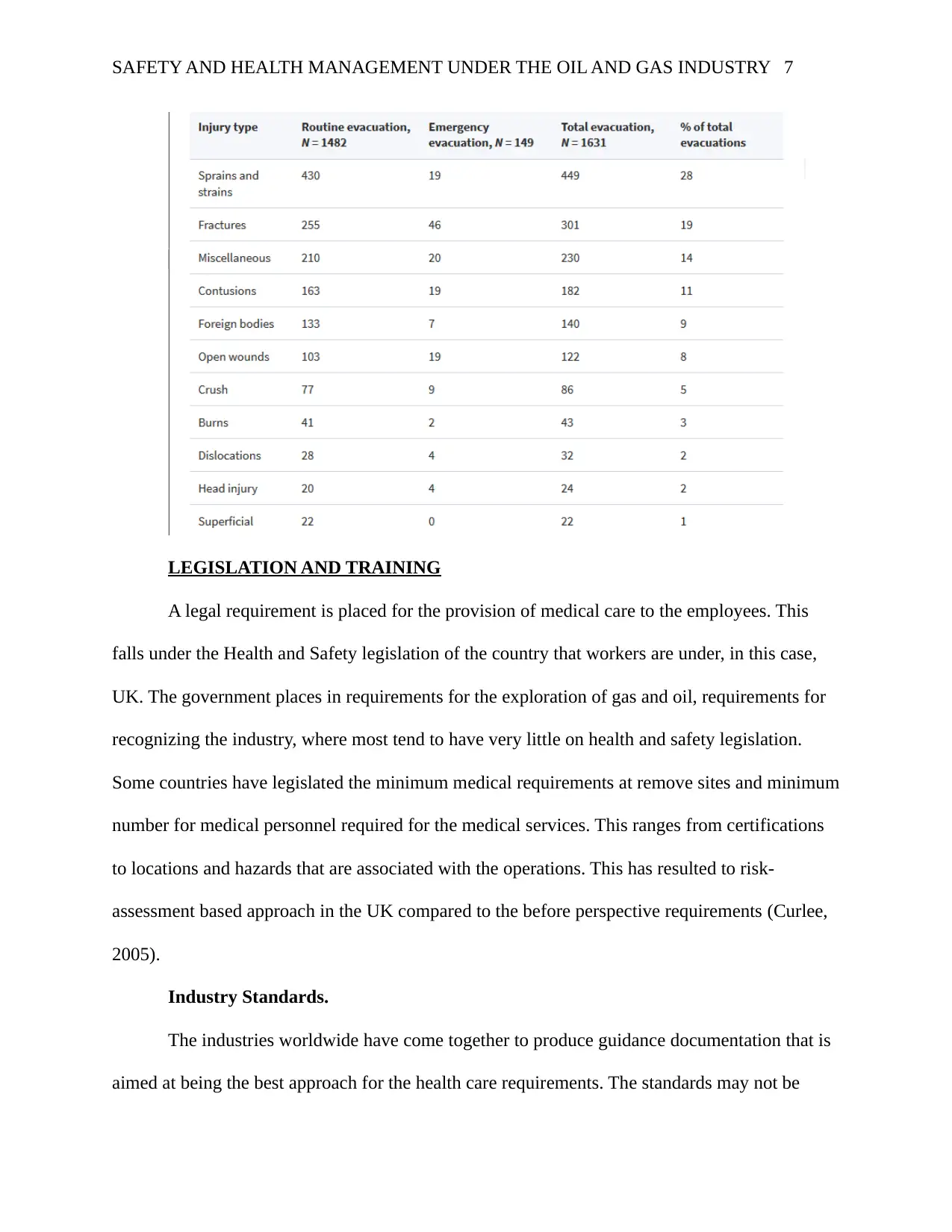
SAFETY AND HEALTH MANAGEMENT UNDER THE OIL AND GAS INDUSTRY 7
LEGISLATION AND TRAINING
A legal requirement is placed for the provision of medical care to the employees. This
falls under the Health and Safety legislation of the country that workers are under, in this case,
UK. The government places in requirements for the exploration of gas and oil, requirements for
recognizing the industry, where most tend to have very little on health and safety legislation.
Some countries have legislated the minimum medical requirements at remove sites and minimum
number for medical personnel required for the medical services. This ranges from certifications
to locations and hazards that are associated with the operations. This has resulted to risk-
assessment based approach in the UK compared to the before perspective requirements (Curlee,
2005).
Industry Standards.
The industries worldwide have come together to produce guidance documentation that is
aimed at being the best approach for the health care requirements. The standards may not be
LEGISLATION AND TRAINING
A legal requirement is placed for the provision of medical care to the employees. This
falls under the Health and Safety legislation of the country that workers are under, in this case,
UK. The government places in requirements for the exploration of gas and oil, requirements for
recognizing the industry, where most tend to have very little on health and safety legislation.
Some countries have legislated the minimum medical requirements at remove sites and minimum
number for medical personnel required for the medical services. This ranges from certifications
to locations and hazards that are associated with the operations. This has resulted to risk-
assessment based approach in the UK compared to the before perspective requirements (Curlee,
2005).
Industry Standards.
The industries worldwide have come together to produce guidance documentation that is
aimed at being the best approach for the health care requirements. The standards may not be
Paraphrase This Document
Need a fresh take? Get an instant paraphrase of this document with our AI Paraphraser
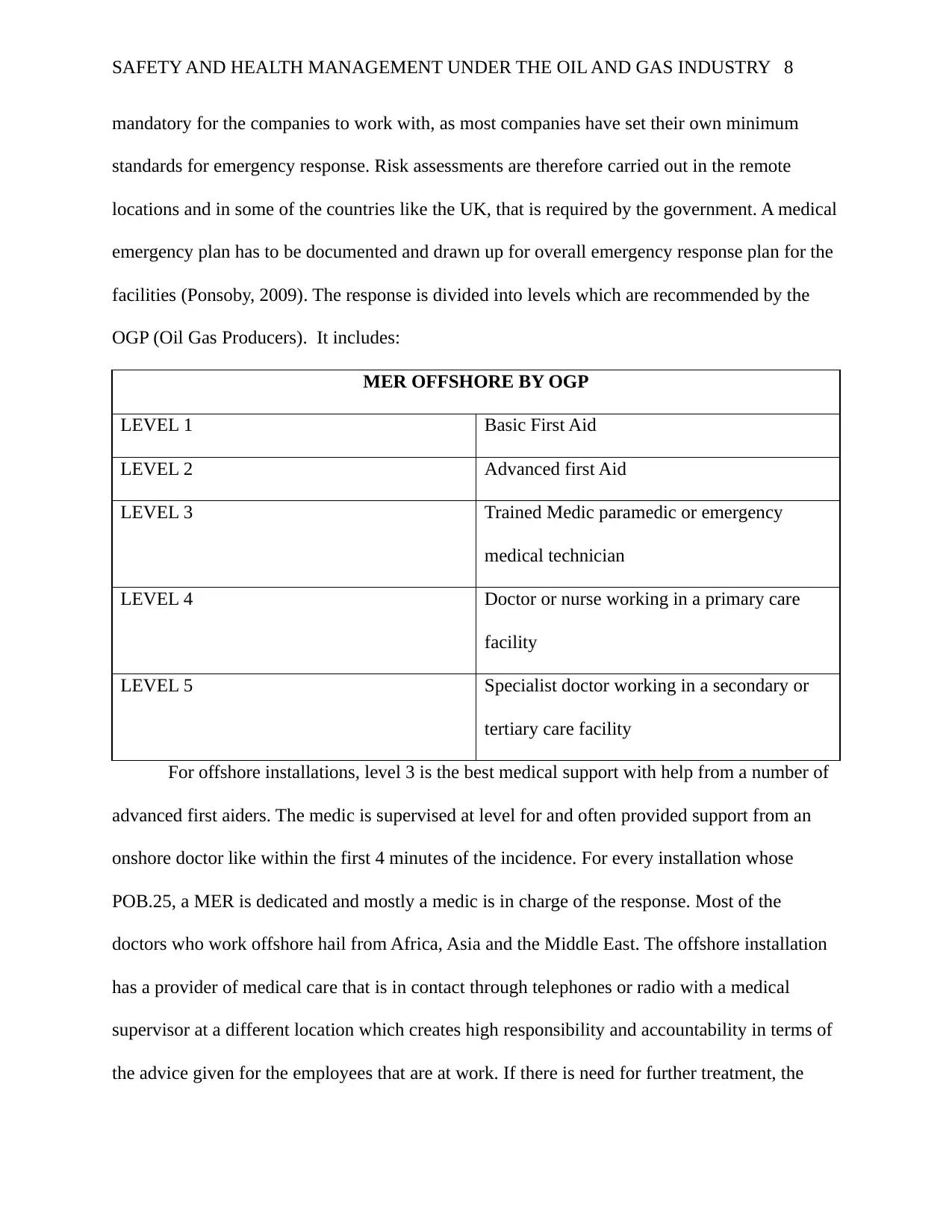
SAFETY AND HEALTH MANAGEMENT UNDER THE OIL AND GAS INDUSTRY 8
mandatory for the companies to work with, as most companies have set their own minimum
standards for emergency response. Risk assessments are therefore carried out in the remote
locations and in some of the countries like the UK, that is required by the government. A medical
emergency plan has to be documented and drawn up for overall emergency response plan for the
facilities (Ponsoby, 2009). The response is divided into levels which are recommended by the
OGP (Oil Gas Producers). It includes:
MER OFFSHORE BY OGP
LEVEL 1 Basic First Aid
LEVEL 2 Advanced first Aid
LEVEL 3 Trained Medic paramedic or emergency
medical technician
LEVEL 4 Doctor or nurse working in a primary care
facility
LEVEL 5 Specialist doctor working in a secondary or
tertiary care facility
For offshore installations, level 3 is the best medical support with help from a number of
advanced first aiders. The medic is supervised at level for and often provided support from an
onshore doctor like within the first 4 minutes of the incidence. For every installation whose
POB.25, a MER is dedicated and mostly a medic is in charge of the response. Most of the
doctors who work offshore hail from Africa, Asia and the Middle East. The offshore installation
has a provider of medical care that is in contact through telephones or radio with a medical
supervisor at a different location which creates high responsibility and accountability in terms of
the advice given for the employees that are at work. If there is need for further treatment, the
mandatory for the companies to work with, as most companies have set their own minimum
standards for emergency response. Risk assessments are therefore carried out in the remote
locations and in some of the countries like the UK, that is required by the government. A medical
emergency plan has to be documented and drawn up for overall emergency response plan for the
facilities (Ponsoby, 2009). The response is divided into levels which are recommended by the
OGP (Oil Gas Producers). It includes:
MER OFFSHORE BY OGP
LEVEL 1 Basic First Aid
LEVEL 2 Advanced first Aid
LEVEL 3 Trained Medic paramedic or emergency
medical technician
LEVEL 4 Doctor or nurse working in a primary care
facility
LEVEL 5 Specialist doctor working in a secondary or
tertiary care facility
For offshore installations, level 3 is the best medical support with help from a number of
advanced first aiders. The medic is supervised at level for and often provided support from an
onshore doctor like within the first 4 minutes of the incidence. For every installation whose
POB.25, a MER is dedicated and mostly a medic is in charge of the response. Most of the
doctors who work offshore hail from Africa, Asia and the Middle East. The offshore installation
has a provider of medical care that is in contact through telephones or radio with a medical
supervisor at a different location which creates high responsibility and accountability in terms of
the advice given for the employees that are at work. If there is need for further treatment, the
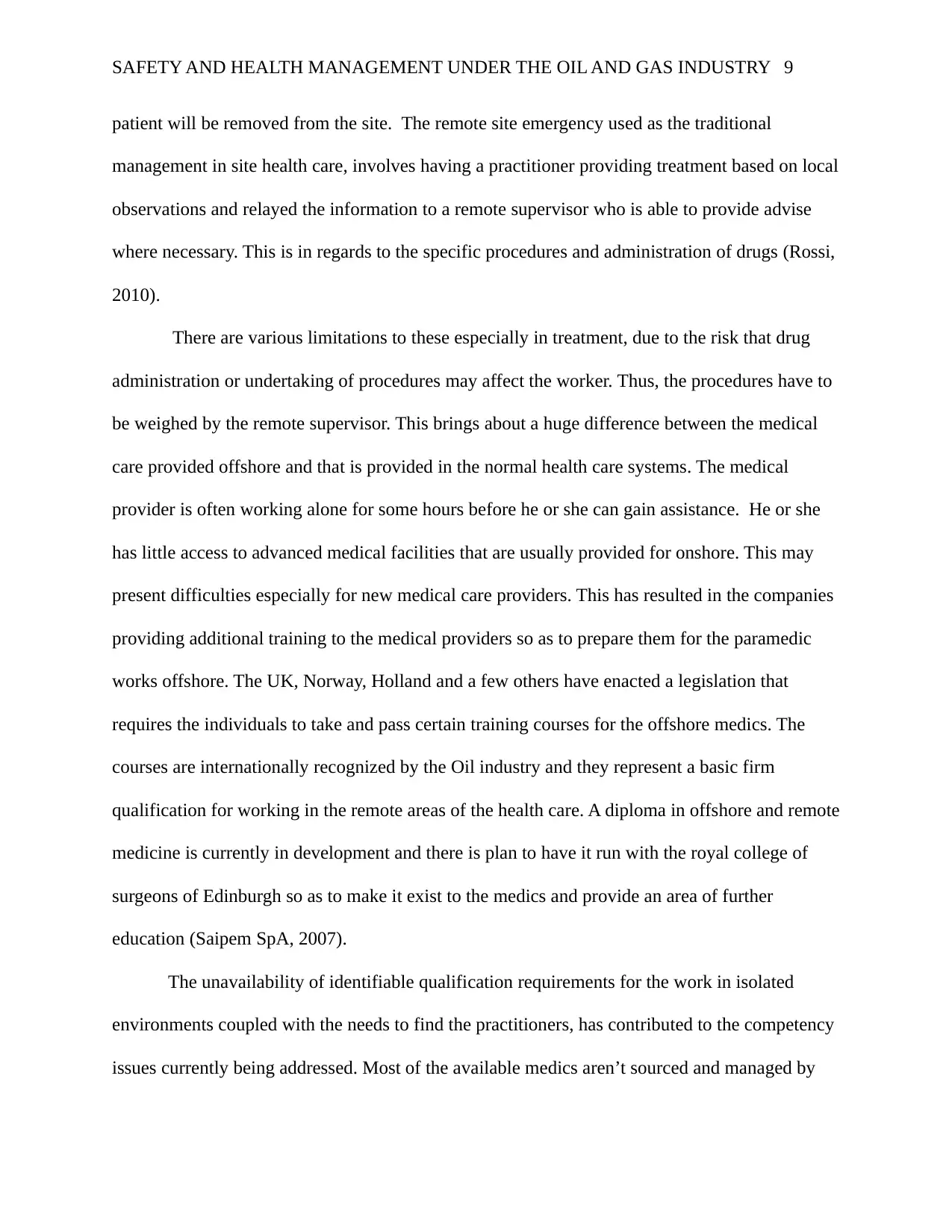
SAFETY AND HEALTH MANAGEMENT UNDER THE OIL AND GAS INDUSTRY 9
patient will be removed from the site. The remote site emergency used as the traditional
management in site health care, involves having a practitioner providing treatment based on local
observations and relayed the information to a remote supervisor who is able to provide advise
where necessary. This is in regards to the specific procedures and administration of drugs (Rossi,
2010).
There are various limitations to these especially in treatment, due to the risk that drug
administration or undertaking of procedures may affect the worker. Thus, the procedures have to
be weighed by the remote supervisor. This brings about a huge difference between the medical
care provided offshore and that is provided in the normal health care systems. The medical
provider is often working alone for some hours before he or she can gain assistance. He or she
has little access to advanced medical facilities that are usually provided for onshore. This may
present difficulties especially for new medical care providers. This has resulted in the companies
providing additional training to the medical providers so as to prepare them for the paramedic
works offshore. The UK, Norway, Holland and a few others have enacted a legislation that
requires the individuals to take and pass certain training courses for the offshore medics. The
courses are internationally recognized by the Oil industry and they represent a basic firm
qualification for working in the remote areas of the health care. A diploma in offshore and remote
medicine is currently in development and there is plan to have it run with the royal college of
surgeons of Edinburgh so as to make it exist to the medics and provide an area of further
education (Saipem SpA, 2007).
The unavailability of identifiable qualification requirements for the work in isolated
environments coupled with the needs to find the practitioners, has contributed to the competency
issues currently being addressed. Most of the available medics aren’t sourced and managed by
patient will be removed from the site. The remote site emergency used as the traditional
management in site health care, involves having a practitioner providing treatment based on local
observations and relayed the information to a remote supervisor who is able to provide advise
where necessary. This is in regards to the specific procedures and administration of drugs (Rossi,
2010).
There are various limitations to these especially in treatment, due to the risk that drug
administration or undertaking of procedures may affect the worker. Thus, the procedures have to
be weighed by the remote supervisor. This brings about a huge difference between the medical
care provided offshore and that is provided in the normal health care systems. The medical
provider is often working alone for some hours before he or she can gain assistance. He or she
has little access to advanced medical facilities that are usually provided for onshore. This may
present difficulties especially for new medical care providers. This has resulted in the companies
providing additional training to the medical providers so as to prepare them for the paramedic
works offshore. The UK, Norway, Holland and a few others have enacted a legislation that
requires the individuals to take and pass certain training courses for the offshore medics. The
courses are internationally recognized by the Oil industry and they represent a basic firm
qualification for working in the remote areas of the health care. A diploma in offshore and remote
medicine is currently in development and there is plan to have it run with the royal college of
surgeons of Edinburgh so as to make it exist to the medics and provide an area of further
education (Saipem SpA, 2007).
The unavailability of identifiable qualification requirements for the work in isolated
environments coupled with the needs to find the practitioners, has contributed to the competency
issues currently being addressed. Most of the available medics aren’t sourced and managed by
⊘ This is a preview!⊘
Do you want full access?
Subscribe today to unlock all pages.

Trusted by 1+ million students worldwide
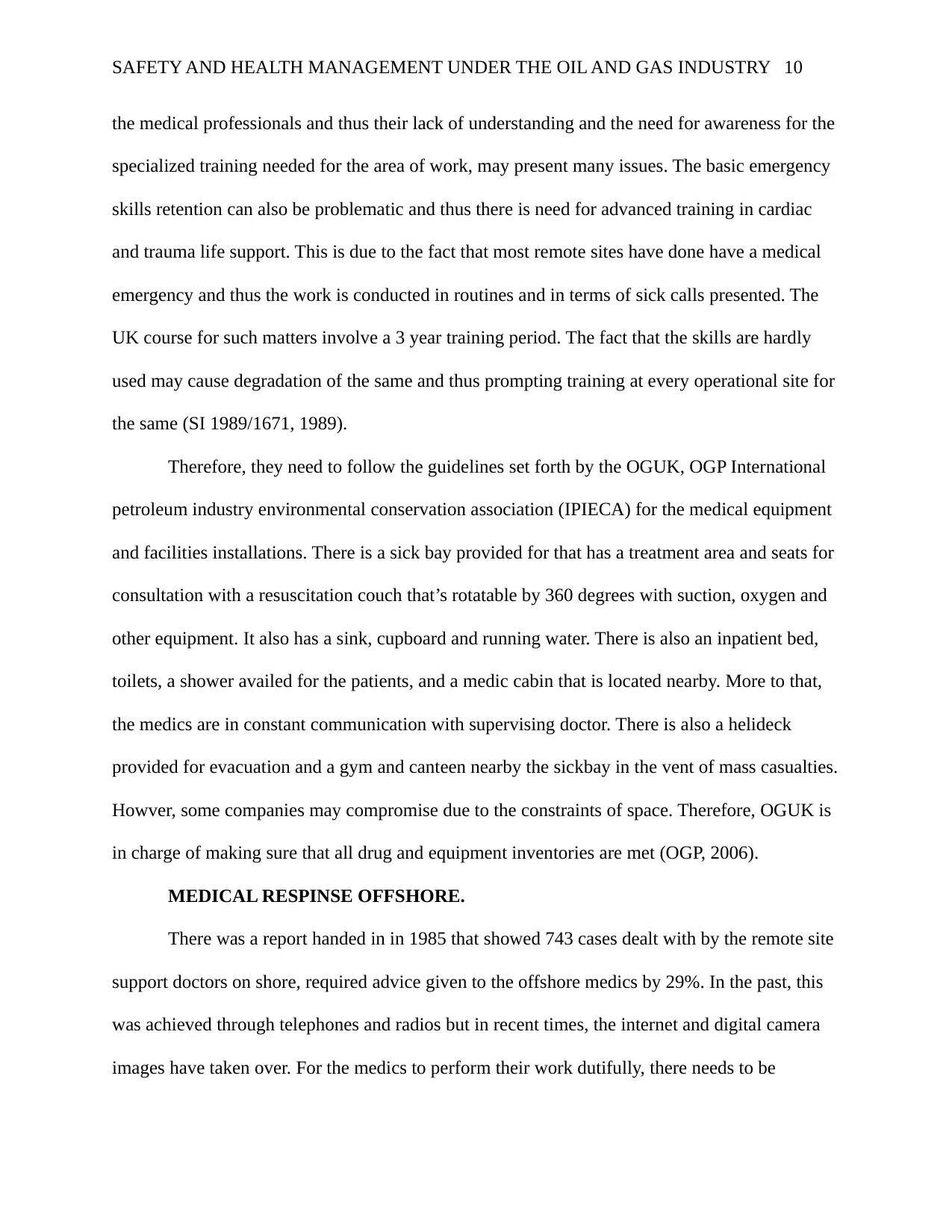
SAFETY AND HEALTH MANAGEMENT UNDER THE OIL AND GAS INDUSTRY 10
the medical professionals and thus their lack of understanding and the need for awareness for the
specialized training needed for the area of work, may present many issues. The basic emergency
skills retention can also be problematic and thus there is need for advanced training in cardiac
and trauma life support. This is due to the fact that most remote sites have done have a medical
emergency and thus the work is conducted in routines and in terms of sick calls presented. The
UK course for such matters involve a 3 year training period. The fact that the skills are hardly
used may cause degradation of the same and thus prompting training at every operational site for
the same (SI 1989/1671, 1989).
Therefore, they need to follow the guidelines set forth by the OGUK, OGP International
petroleum industry environmental conservation association (IPIECA) for the medical equipment
and facilities installations. There is a sick bay provided for that has a treatment area and seats for
consultation with a resuscitation couch that’s rotatable by 360 degrees with suction, oxygen and
other equipment. It also has a sink, cupboard and running water. There is also an inpatient bed,
toilets, a shower availed for the patients, and a medic cabin that is located nearby. More to that,
the medics are in constant communication with supervising doctor. There is also a helideck
provided for evacuation and a gym and canteen nearby the sickbay in the vent of mass casualties.
Howver, some companies may compromise due to the constraints of space. Therefore, OGUK is
in charge of making sure that all drug and equipment inventories are met (OGP, 2006).
MEDICAL RESPINSE OFFSHORE.
There was a report handed in in 1985 that showed 743 cases dealt with by the remote site
support doctors on shore, required advice given to the offshore medics by 29%. In the past, this
was achieved through telephones and radios but in recent times, the internet and digital camera
images have taken over. For the medics to perform their work dutifully, there needs to be
the medical professionals and thus their lack of understanding and the need for awareness for the
specialized training needed for the area of work, may present many issues. The basic emergency
skills retention can also be problematic and thus there is need for advanced training in cardiac
and trauma life support. This is due to the fact that most remote sites have done have a medical
emergency and thus the work is conducted in routines and in terms of sick calls presented. The
UK course for such matters involve a 3 year training period. The fact that the skills are hardly
used may cause degradation of the same and thus prompting training at every operational site for
the same (SI 1989/1671, 1989).
Therefore, they need to follow the guidelines set forth by the OGUK, OGP International
petroleum industry environmental conservation association (IPIECA) for the medical equipment
and facilities installations. There is a sick bay provided for that has a treatment area and seats for
consultation with a resuscitation couch that’s rotatable by 360 degrees with suction, oxygen and
other equipment. It also has a sink, cupboard and running water. There is also an inpatient bed,
toilets, a shower availed for the patients, and a medic cabin that is located nearby. More to that,
the medics are in constant communication with supervising doctor. There is also a helideck
provided for evacuation and a gym and canteen nearby the sickbay in the vent of mass casualties.
Howver, some companies may compromise due to the constraints of space. Therefore, OGUK is
in charge of making sure that all drug and equipment inventories are met (OGP, 2006).
MEDICAL RESPINSE OFFSHORE.
There was a report handed in in 1985 that showed 743 cases dealt with by the remote site
support doctors on shore, required advice given to the offshore medics by 29%. In the past, this
was achieved through telephones and radios but in recent times, the internet and digital camera
images have taken over. For the medics to perform their work dutifully, there needs to be
Paraphrase This Document
Need a fresh take? Get an instant paraphrase of this document with our AI Paraphraser
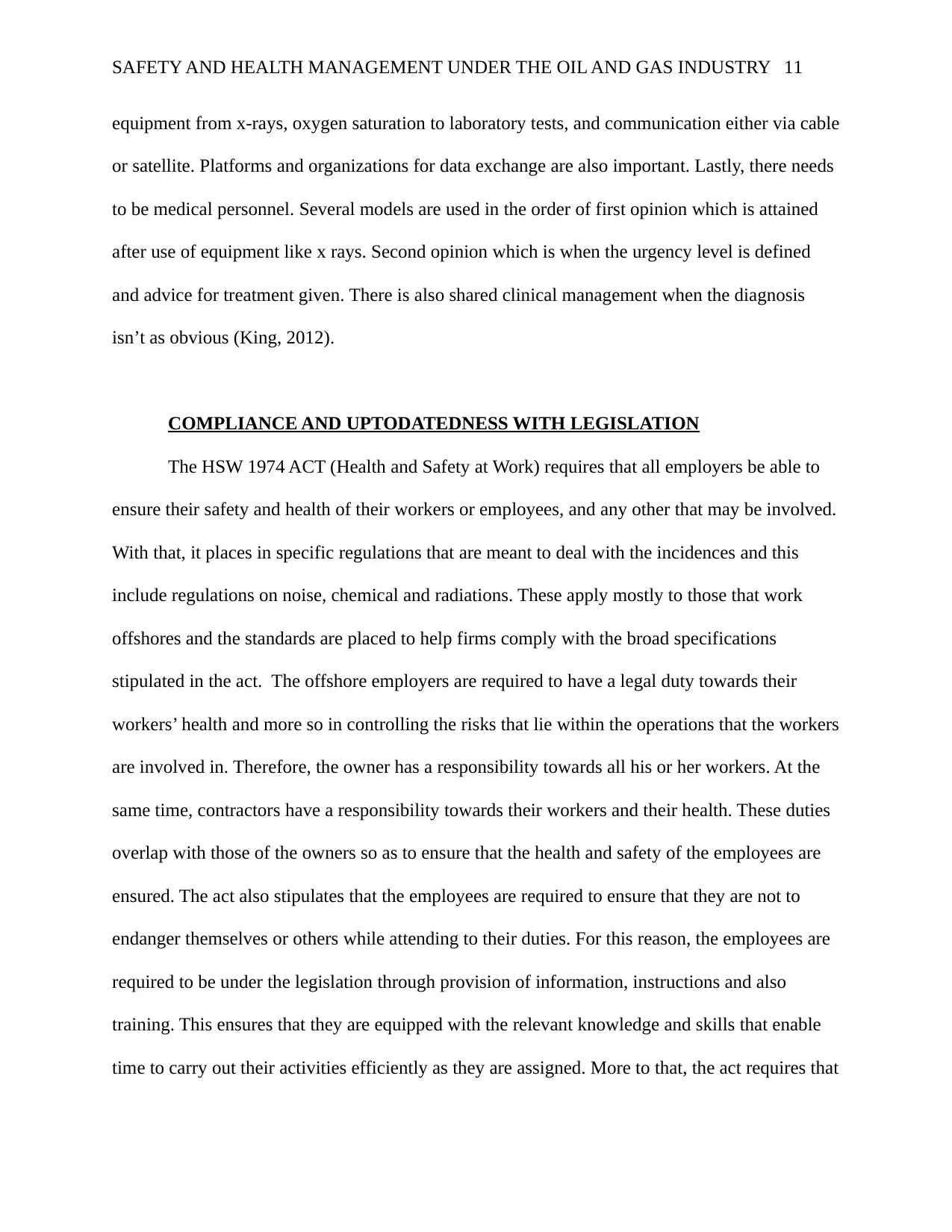
SAFETY AND HEALTH MANAGEMENT UNDER THE OIL AND GAS INDUSTRY 11
equipment from x-rays, oxygen saturation to laboratory tests, and communication either via cable
or satellite. Platforms and organizations for data exchange are also important. Lastly, there needs
to be medical personnel. Several models are used in the order of first opinion which is attained
after use of equipment like x rays. Second opinion which is when the urgency level is defined
and advice for treatment given. There is also shared clinical management when the diagnosis
isn’t as obvious (King, 2012).
COMPLIANCE AND UPTODATEDNESS WITH LEGISLATION
The HSW 1974 ACT (Health and Safety at Work) requires that all employers be able to
ensure their safety and health of their workers or employees, and any other that may be involved.
With that, it places in specific regulations that are meant to deal with the incidences and this
include regulations on noise, chemical and radiations. These apply mostly to those that work
offshores and the standards are placed to help firms comply with the broad specifications
stipulated in the act. The offshore employers are required to have a legal duty towards their
workers’ health and more so in controlling the risks that lie within the operations that the workers
are involved in. Therefore, the owner has a responsibility towards all his or her workers. At the
same time, contractors have a responsibility towards their workers and their health. These duties
overlap with those of the owners so as to ensure that the health and safety of the employees are
ensured. The act also stipulates that the employees are required to ensure that they are not to
endanger themselves or others while attending to their duties. For this reason, the employees are
required to be under the legislation through provision of information, instructions and also
training. This ensures that they are equipped with the relevant knowledge and skills that enable
time to carry out their activities efficiently as they are assigned. More to that, the act requires that
equipment from x-rays, oxygen saturation to laboratory tests, and communication either via cable
or satellite. Platforms and organizations for data exchange are also important. Lastly, there needs
to be medical personnel. Several models are used in the order of first opinion which is attained
after use of equipment like x rays. Second opinion which is when the urgency level is defined
and advice for treatment given. There is also shared clinical management when the diagnosis
isn’t as obvious (King, 2012).
COMPLIANCE AND UPTODATEDNESS WITH LEGISLATION
The HSW 1974 ACT (Health and Safety at Work) requires that all employers be able to
ensure their safety and health of their workers or employees, and any other that may be involved.
With that, it places in specific regulations that are meant to deal with the incidences and this
include regulations on noise, chemical and radiations. These apply mostly to those that work
offshores and the standards are placed to help firms comply with the broad specifications
stipulated in the act. The offshore employers are required to have a legal duty towards their
workers’ health and more so in controlling the risks that lie within the operations that the workers
are involved in. Therefore, the owner has a responsibility towards all his or her workers. At the
same time, contractors have a responsibility towards their workers and their health. These duties
overlap with those of the owners so as to ensure that the health and safety of the employees are
ensured. The act also stipulates that the employees are required to ensure that they are not to
endanger themselves or others while attending to their duties. For this reason, the employees are
required to be under the legislation through provision of information, instructions and also
training. This ensures that they are equipped with the relevant knowledge and skills that enable
time to carry out their activities efficiently as they are assigned. More to that, the act requires that
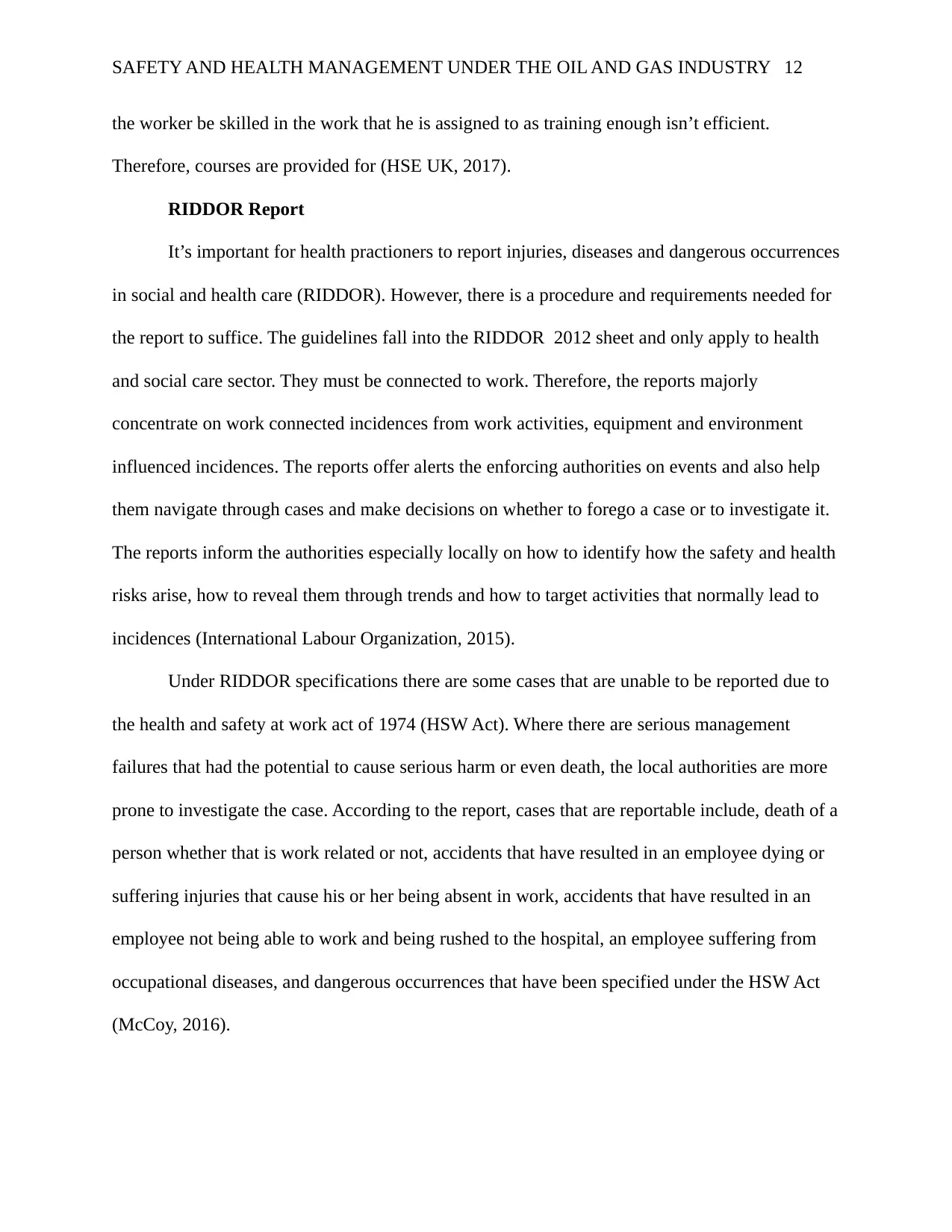
SAFETY AND HEALTH MANAGEMENT UNDER THE OIL AND GAS INDUSTRY 12
the worker be skilled in the work that he is assigned to as training enough isn’t efficient.
Therefore, courses are provided for (HSE UK, 2017).
RIDDOR Report
It’s important for health practioners to report injuries, diseases and dangerous occurrences
in social and health care (RIDDOR). However, there is a procedure and requirements needed for
the report to suffice. The guidelines fall into the RIDDOR 2012 sheet and only apply to health
and social care sector. They must be connected to work. Therefore, the reports majorly
concentrate on work connected incidences from work activities, equipment and environment
influenced incidences. The reports offer alerts the enforcing authorities on events and also help
them navigate through cases and make decisions on whether to forego a case or to investigate it.
The reports inform the authorities especially locally on how to identify how the safety and health
risks arise, how to reveal them through trends and how to target activities that normally lead to
incidences (International Labour Organization, 2015).
Under RIDDOR specifications there are some cases that are unable to be reported due to
the health and safety at work act of 1974 (HSW Act). Where there are serious management
failures that had the potential to cause serious harm or even death, the local authorities are more
prone to investigate the case. According to the report, cases that are reportable include, death of a
person whether that is work related or not, accidents that have resulted in an employee dying or
suffering injuries that cause his or her being absent in work, accidents that have resulted in an
employee not being able to work and being rushed to the hospital, an employee suffering from
occupational diseases, and dangerous occurrences that have been specified under the HSW Act
(McCoy, 2016).
the worker be skilled in the work that he is assigned to as training enough isn’t efficient.
Therefore, courses are provided for (HSE UK, 2017).
RIDDOR Report
It’s important for health practioners to report injuries, diseases and dangerous occurrences
in social and health care (RIDDOR). However, there is a procedure and requirements needed for
the report to suffice. The guidelines fall into the RIDDOR 2012 sheet and only apply to health
and social care sector. They must be connected to work. Therefore, the reports majorly
concentrate on work connected incidences from work activities, equipment and environment
influenced incidences. The reports offer alerts the enforcing authorities on events and also help
them navigate through cases and make decisions on whether to forego a case or to investigate it.
The reports inform the authorities especially locally on how to identify how the safety and health
risks arise, how to reveal them through trends and how to target activities that normally lead to
incidences (International Labour Organization, 2015).
Under RIDDOR specifications there are some cases that are unable to be reported due to
the health and safety at work act of 1974 (HSW Act). Where there are serious management
failures that had the potential to cause serious harm or even death, the local authorities are more
prone to investigate the case. According to the report, cases that are reportable include, death of a
person whether that is work related or not, accidents that have resulted in an employee dying or
suffering injuries that cause his or her being absent in work, accidents that have resulted in an
employee not being able to work and being rushed to the hospital, an employee suffering from
occupational diseases, and dangerous occurrences that have been specified under the HSW Act
(McCoy, 2016).
⊘ This is a preview!⊘
Do you want full access?
Subscribe today to unlock all pages.

Trusted by 1+ million students worldwide
1 out of 24
Related Documents
Your All-in-One AI-Powered Toolkit for Academic Success.
+13062052269
info@desklib.com
Available 24*7 on WhatsApp / Email
![[object Object]](/_next/static/media/star-bottom.7253800d.svg)
Unlock your academic potential
Copyright © 2020–2025 A2Z Services. All Rights Reserved. Developed and managed by ZUCOL.



